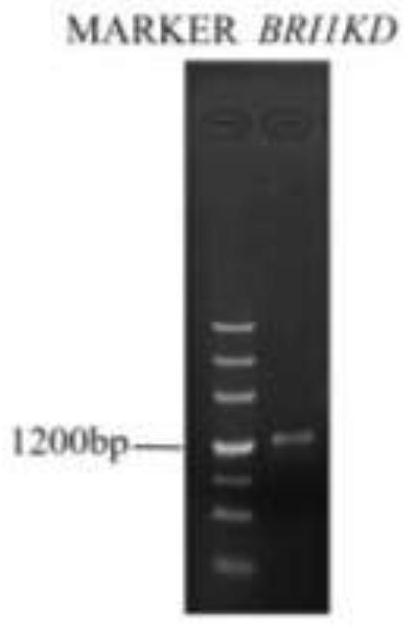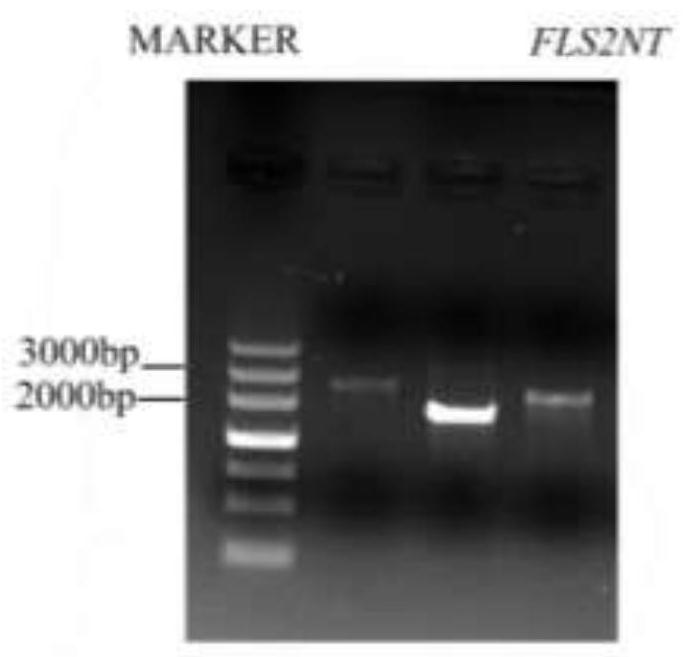Application and method of bri1 in plant immune signal verification
A verification method, plant technology, applied in the application field of plant immune signal verification, can solve the problems of limiting multi-antigen recombinant proteins, interference, and difficulty in accurately determining whether immune components have elicitor activity
- Summary
- Abstract
- Description
- Claims
- Application Information
AI Technical Summary
Problems solved by technology
Method used
Image
Examples
Embodiment 1
[0041] Embodiment 1 molecular cloning experiment
[0042] 1. PCR amplification of BRI1KD
[0043] Using the Arabidopsis genomic DNA preserved in our laboratory as a template, according to the characteristics of the carrier HBT-GFP, the restriction endonuclease KpnI / SpeI was selected, and the primers for BRI1KD cloning were designed as shown in Table 1, and the reaction system was shown in Table 2. The PCR amplification reaction conditions are shown in Table 3, and the final product was stored at 4°C.
[0044] Table 1 PCR reaction primer information
[0045]
[0046] Table 2 PCR reaction system
[0047]
[0048]
[0049] Table 3 PCR amplification reaction conditions
[0050]
[0051] The PCR product was purified, and the PCR product was purified using a kit from Beijing Tiangen Co., Ltd.
[0052] 2.T 4 DNA ligase ligation reaction
[0053] The connection system is shown in Table 4, and the reaction steps are as follows:
[0054] (1) Add the reaction reagents ...
Embodiment 2
[0091] Embodiment 2 protoplast transformation experiment
[0092] 1. Preparation of Protoplasts from Arabidopsis Mesophyll Cells
[0093] The specific operation of Arabidopsis mesophyll cell protoplast preparation is as follows:
[0094] (1) Configure the protoplast enzymolysis solution, filter it with a 2.2 μm filter head and set it aside;
[0095] (2) Using col-0 wild-type Arabidopsis leaves cultivated for 4 weeks in an artificial climate as material, after removing the head and tail of the leaves, cut the leaves into 0.5-1mm filaments;
[0096] (3) rapidly immerse the blades of the cut filaments in the enzymolysis solution;
[0097] (4) Under the culture condition of 23°C, enzymatically hydrolyze the leaves for 4 hours in the dark;
[0098] (5) After the leaves are completely lysed, add an equal volume of W5 to the lysate, filter the enzymatic solution added with W5 into a 50 mL centrifuge tube with gauze, and centrifuge horizontally at 80 rcf / min for 2 min;
[0099] (6...
PUM
 Login to View More
Login to View More Abstract
Description
Claims
Application Information
 Login to View More
Login to View More - R&D
- Intellectual Property
- Life Sciences
- Materials
- Tech Scout
- Unparalleled Data Quality
- Higher Quality Content
- 60% Fewer Hallucinations
Browse by: Latest US Patents, China's latest patents, Technical Efficacy Thesaurus, Application Domain, Technology Topic, Popular Technical Reports.
© 2025 PatSnap. All rights reserved.Legal|Privacy policy|Modern Slavery Act Transparency Statement|Sitemap|About US| Contact US: help@patsnap.com



